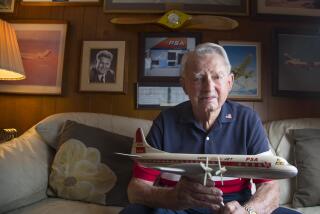Samuel Miller, 84; Piloted Historic Flight
- Share via
The 111 well-dressed and well-heeled passengers, actress Greer Garson among them, lifted off into the mist, ready to dine on pheasant in brandy sauce prepared by Maxim’s of Paris.
They had room to stretch, room to stand, champagne to sip and history to make.
“We shrunk the world,” said Samuel H. Miller, the pilot at the controls of the Pan American World Airways Boeing 707-121 Clipper America that made the first scheduled trans-Atlantic jet passenger flight Oct. 26, 1958.
The flight for the history books from New York’s Idlewild (now John F. Kennedy) International Airport to Paris’ Le Bourget, with a refueling stop in Gander, Newfoundland, took 8 hours, 41 minutes--nearly halving the crossing time by propeller plane.
“After that,” the pilot said, “jets caught on like wildfire.”
Capt. Miller, then chief pilot of Pan Am’s Atlantic Division and later its vice president for operations, died Aug. 31 in Bradenton, Fla., where he had lived for the last 15 years. He was 84.
That initial jet passenger flight, a Pan Am historian noted in 1978, “was the first of its kind by a U.S. operator and marked the beginning of the big-jet age.”
And, oh, the changes Miller lived to see in the airline and travel industry he helped prod into growing up.
Now, instead of the single scheduled New York-to-Paris jet flight each day that he initiated, there are more than 10. The bigger jets never have to stop to refuel and spend less than seven hours in the air.
That frequency and speed have considerably reduced the fares of 1958, which, in today’s dollars, were about $2,300 for economy class and $4,500 for first class.
The historic 707 was sold to an aircraft brokerage in 1975. Miller retired in 1977. And Pan Am went out of business in 1992.
When Miller flew--as a passenger of honor--on the 25th anniversary re-creation of his historic flight, the glamour and comfort of jet travel had already begun to decline, along with the prices.
Confined to such limited space that they must writhe like laboratory rats to crawl into seats, passengers no longer dress up to fly. And they know that when and if food is served, it is not likely to be from any critically acclaimed restaurant. Flying time may be shorter, but runway waits and other delays because of crowded skies and airports lengthen the trip.
“We had the sky to ourselves that night,” was a nostalgic phrase when Miller said it in 1998, fondly remembering what it was like to fly that first Flight 114 to Paris 40 years earlier.
Before his passengers were welcomed aboard on that long-ago October night, Miller had taken the Boeing 707 across the Atlantic six times just to be sure he got it right.
By then he was already a veteran pilot, mostly for the pioneering Pan Am. A dozen years before his jet debut, he was piloting a Pan Am Constellation propeller plane over the East Coast when one of its four engines fell off.
Aboard then were Laurence Olivier and Vivien Leigh and 40 other passengers--none of whom was hurt and few of whom even noticed, thanks to Miller’s skill, that they returned to earth in a wheels-up emergency landing.
Born in Carlisle, Ind., Miller graduated from Indiana University, which later designated him one of its distinguished alumni.
He took his flight training in the Army Air Corps and joined Pan Am in 1940, flying government missions during World War II on Pan Am aircraft and American warplanes.
In retirement, Miller remained active in the American Legion, the Wings Club of New York and the Pan Am Historical Foundation of Miami.
He is survived by his daughter, Kristen Bartlett of Easton, Conn.; a son, Brett of San Francisco; a sister, Mary Broome of Longview, Texas; a brother, Max of Sullivan, Ind.; and three grandchildren.
Memorial donations may be sent to the Indiana University Foundation Annual Scholarship Fund, Box 500, Bloomington, IN 47402.
More to Read
Sign up for The Wild
We’ll help you find the best places to hike, bike and run, as well as the perfect silent spots for meditation and yoga.
You may occasionally receive promotional content from the Los Angeles Times.





